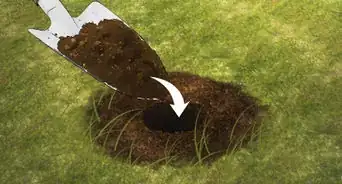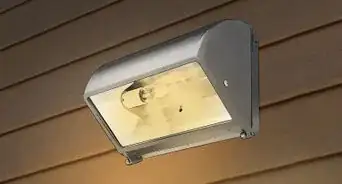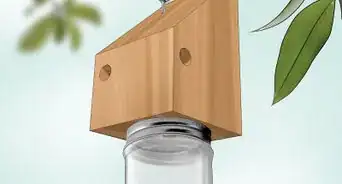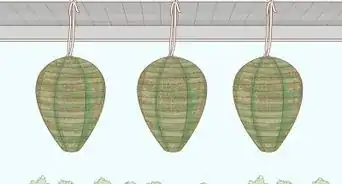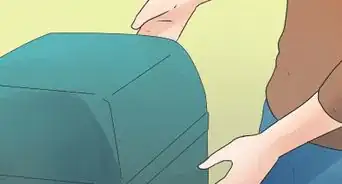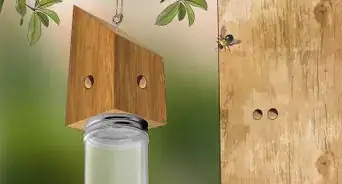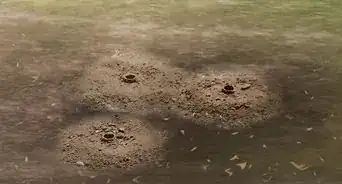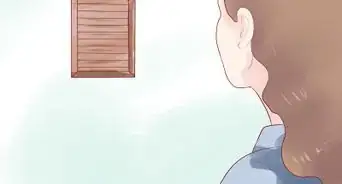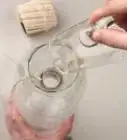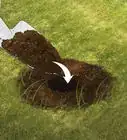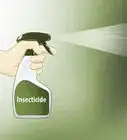wikiHow is a “wiki,” similar to Wikipedia, which means that many of our articles are co-written by multiple authors. To create this article, 30 people, some anonymous, worked to edit and improve it over time.
wikiHow marks an article as reader-approved once it receives enough positive feedback. This article received 50 testimonials and 91% of readers who voted found it helpful, earning it our reader-approved status.
This article has been viewed 1,604,665 times.
Learn more...
This article provides instructions on how to eradicate the ground-digger wasp (also known as the cicada-killer), should you have nest infestations on your lawn or property.
Steps
Background Info
-
1Learn about ground digger wasps. Ground-digger wasps (GDWs) are very large (slightly larger than a green hornet) passive-aggressive wasps that "build" their nests in dry, unfertilized earth. They are typically large and black-bodied with yellow stripes on their back-end. When fully grown, they measure about one and a half inches (or more) in length with about a one and a quarter-inch wide wingspan.[1]
-
2Know the signs of ground digger wasps infesting your lawn or garden space. You'll know you've got ground-digger wasp nests when you see small granular mounds of dirt piled up anywhere from two-to-five inches in height. At the base of the mound of granular dirt will be a finger-sized hole with a "path" of dirt leading out from it.
- The nests will be sporadically built throughout your lawn or garden, but will typically be in the driest areas and/or under longer grass/weeds or under growing flowers. GDWs do not like, but can live in, moist soil.
Advertisement -
3Find out the local life cycle. In the Northeast US, the life-cycle of a ground-digger wasp is about one month beginning in mid-July and ending around mid-to-late August (depending on where you live, their life-cycle may start earlier or later). They go from young adults buzzing about play-attacking with each other, to full-size adults in about two-to-three weeks.
-
4It's important to understand that they only sting when attacked. While very menacing looking, they are passive stingers, meaning only if very threatened will they attack and sting.[2] You'd practically have to start digging into their nests while they're flying about for one to come at you and sting you (so, don't do that!). Otherwise, they tend to buzz about to check you out and to scare you away and they probably will the first time you encounter them. Know that they'd rather get on with their business of killing cicadas up in the trees than sting you.
Removal
-
1While the method suggested here basically kills the wasps in their nests, there is no other (safe- for-nearby-pets) way to eradicate them. It is probable that you will still get nests from year-to-year, but only one, maybe two. The trick is to kill all of them while they're in their nests so their babies will not come back to the same place they were born.
-
2Get the supplies. To eradicate an infestation of ground-digger wasps (GDWs), purchase from your local party store and supermarket, the following items: a) a large bag of white plastic knives, and b) up to three or four jug gallons of regular or lemon ammonia.
-
3During the day, when the wasps are up hunting for cicadas in the trees, mark each nest you find with one of the plastic knives pushed into the ground as close to the hole of the nest as possible (without disturbing the hole). Leave enough of the knife sticking out of the ground so you can see it.
-
4After 10:30 or 11pm, (later is better), that evening, using a flashlight, seek out the knives you placed and carefully pour about two-to-three cups of ammonia into each of the holes. At this time the wasps are probably nesting/sleeping, so you'll be catching them while in the nest. (You can stretch out the amount of ammonia by mixing a one-to-one ratio of water to ammonia. The diluted strength will still be enough to kill them.) Do not remove the knives.
-
5The next day, repeat the process on any new nests that you find in the ground. You'll know the new nests from the old ones because you'll still have the knives in place from the night before. Once you've identified the new nests, remove the old knives.You may have to continually repeat the process depending on the original amount of wasps. Or you could hit the wasps with tennis rackets, knocking them to the ground then step on them.
Community Q&A
Did you know you can get answers researched by wikiHow Staff?
Unlock staff-researched answers by supporting wikiHow
-
QuestionDo cicada killer wasp sting humans?
 wikiHow Staff EditorThis answer was written by one of our trained team of researchers who validated it for accuracy and comprehensiveness.
wikiHow Staff EditorThis answer was written by one of our trained team of researchers who validated it for accuracy and comprehensiveness.
Staff Answer wikiHow Staff EditorStaff AnswerCicada killer wasps are not aggressive toward human beings and prefer to retreat than attack. The female cicada killer wasp can sting humans but usually this only happens by accident; if trodden on or stuck in clothes or shoes by accident, the wasp may sting in self defense. The male wasp does not have a stinger, only a sharp spine to jab with. Take care where you step and don’t bother the wasps and they won’t bother you.
wikiHow Staff EditorStaff AnswerCicada killer wasps are not aggressive toward human beings and prefer to retreat than attack. The female cicada killer wasp can sting humans but usually this only happens by accident; if trodden on or stuck in clothes or shoes by accident, the wasp may sting in self defense. The male wasp does not have a stinger, only a sharp spine to jab with. Take care where you step and don’t bother the wasps and they won’t bother you. -
QuestionDo Digger Wasps sting humans?
 wikiHow Staff EditorThis answer was written by one of our trained team of researchers who validated it for accuracy and comprehensiveness.
wikiHow Staff EditorThis answer was written by one of our trained team of researchers who validated it for accuracy and comprehensiveness.
Staff Answer wikiHow Staff EditorStaff AnswerWhile only the female digger wasp has the ability to sting, this is not an aggressive wasp toward humans. The only reason a digger wasp would sting a human is if she felt threatened or harassed. To stay safe, keep away from the nest and don’t handle or bother digger wasps. These wasps bring benefits to your yard/garden in the form of eating insects and aerating your lawn, so it’s good practice to leave them be and they’ll do the same for you.
wikiHow Staff EditorStaff AnswerWhile only the female digger wasp has the ability to sting, this is not an aggressive wasp toward humans. The only reason a digger wasp would sting a human is if she felt threatened or harassed. To stay safe, keep away from the nest and don’t handle or bother digger wasps. These wasps bring benefits to your yard/garden in the form of eating insects and aerating your lawn, so it’s good practice to leave them be and they’ll do the same for you. -
QuestionIf ammonia kills the grass, will the grass eventually grow back, or do I need to reseed it?
 Community AnswerYou need to reseed it. The ammonia kills everything around it.
Community AnswerYou need to reseed it. The ammonia kills everything around it.
Warnings
- Use a low-powered flash light when treating the nests at night. Even at night GDWs will fly towards a very bright light.⧼thumbs_response⧽
- Before you mow in the summer, check thoroughly through your yard to make sure you don't run into the holes when mowing. The loud sound of the mower, plus it vibrating on the ground will cause the GDWs to get aggravated. And when you go to mow over the hole and get over it, will cause GDWs to come out of the hole and sting you. Check for holes to make sure, being that the grass will be high and you won't be able to see the hole very well.⧼thumbs_response⧽
- Do not try to step on them; they're very fast when they're young adults/adults. As they get older, they tend to slow down, but can still sting if threatened.⧼thumbs_response⧽
- Do not agitate or aggravate a GDW. They may attack and sting you if their nests are threatened in any way. However be advised the males don't even have stingers, and the females sting under extreme provocation only. Wikipedia reports the female stings as relatively "weak". As such, it's important that you follow the above steps when you don't see any GDWs flying around; wait until they're either be up in the trees (during the day) or in the nest (if at night).⧼thumbs_response⧽
Things You'll Need
- Large bag of white plastic party knives
- Up to four or more gallons of ammonia (regular or lemon)
References
About This Article
To get rid of ground digger wasps or cicada killers from your lawn, mark every hole you see with a plastic knife. Then, at 11 p.m. or later, pour a solution of 50% vinegar and 50% water into each hole, putting 2 to 3 cups in each hole. Come back out the next day, mark any new holes you see, and repeat the process until they are all dead. Keep reading for tips on how to deal with them if you decide not to kill them.
-from-Your-Lawn-Step-1-Version-3.webp)
-from-Your-Lawn-Step-2-Version-3.webp)
-from-Your-Lawn-Step-3-Version-3.webp)
-from-Your-Lawn-Step-4-Version-3.webp)
-from-Your-Lawn-Step-5-Version-3.webp)
-from-Your-Lawn-Step-6-Version-3.webp)
-from-Your-Lawn-Step-7-Version-3.webp)
-from-Your-Lawn-Step-8-Version-3.webp)
-from-Your-Lawn-Step-9-Version-3.webp)
-from-Your-Lawn-Step-10.webp)
